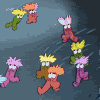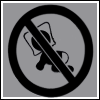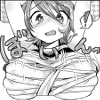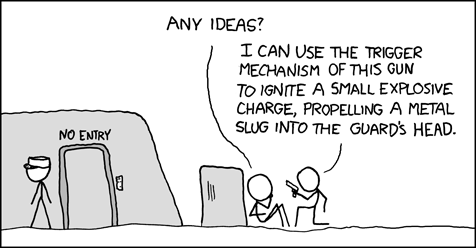what is the best way to KILL a person ??? |
  |
 Jul 1 2008, 01:09 PM Jul 1 2008, 01:09 PM
Post
#26
|
|
 What Up, Whats Hapening      Group: Member Posts: 360 Joined: Aug 2007 Member No: 554,698 |
Nah I could do it. I'd burn the legs and arms but all the guts and stuff I would take out in the hand fulls and grind it up and feed it to the birds. er well probably the stray dogs and cats. I think it'd be cool to cut off a girls boobs. I mean once she was dead of course. hahaaha holy sh!t ur twisted |
|
|
|
 Jul 6 2008, 01:33 AM Jul 6 2008, 01:33 AM
Post
#27
|
|
|
Senior Member     Group: Member Posts: 115 Joined: May 2008 Member No: 650,841 |
Eat the body, including the bones, so that there is no trace. hey i tried cooking some of the flesh from the body. it doesnt taste good i added a bit of salt and pepper to make it edible. apart from that do you have any recipes on how to cook the body also can i use nandos marinade to cook the body? let me know |
|
|
|
 Jul 6 2008, 01:40 AM Jul 6 2008, 01:40 AM
Post
#28
|
|
 Senior Member      Group: Member Posts: 351 Joined: Jul 2007 Member No: 543,127 |
i'd make human jerky out of em and feed it to unsuspecting and hungry cub scouts.
|
|
|
|
 Jul 6 2008, 02:00 AM Jul 6 2008, 02:00 AM
Post
#29
|
|
 Lets Get Dead      Group: Member Posts: 381 Joined: Apr 2008 Member No: 641,562 |
Oh you must live in a city, here where I live you can have bon fires in your yard. So I'd get away with it. And its not like the pieces of body would actually be like fingers and toes and stuff, it would like like grinded up. I bet I could make a tasty burger out of some human. XD Totally reminds me of Fried Green Tomatoes. Icicle. The perfect weapon. |
|
|
|
 Jul 6 2008, 05:02 PM Jul 6 2008, 05:02 PM
Post
#30
|
|
 Senior Member         Group: Head Staff Posts: 18,173 Joined: Mar 2005 Member No: 108,478 |
With a wooden stick.
|
|
|
|
 Jul 7 2008, 08:01 AM Jul 7 2008, 08:01 AM
Post
#31
|
|
 This bag is not a toy.        Group: Staff Alumni Posts: 3,090 Joined: Oct 2007 Member No: 583,108 |
Sounds like you don't need help killing a person, but rather actually disposing of the body.
|
|
|
|
 Jul 7 2008, 08:42 AM Jul 7 2008, 08:42 AM
Post
#32
|
|
 /人◕‿‿◕人\        Group: Official Member Posts: 8,283 Joined: Dec 2007 Member No: 602,927 |
I've got something stored on my computer somewhere...
Found it. Body Preparation: Acquiring your subject is up to you. For best results and health, freshness is imperative. A living human in captivity is optimal, but not always available. When possible make sure the animal has no food for 48 hours, but plenty of water. This fasting helps flush the system, purging stored toxins and bodily wastes, as well as making bleeding and cleaning easier. Under ideal conditions, the specimen will then be stunned into insensitivity. Sharp unexpected blows to the head are best, tranquilizers not being recommended as they may taint the flavor of the meat. If this is not possible without exciting the animal and causing a struggle (which will pump a greater volume of blood and secretions such as adrenaline throughout the body), a single bullet through the middle of the forehead or back of the skull will suffice. Hanging: Once the animal is unconscious or dead, it is ready to be hoisted. Get the feet up first, then the hands, with the head down. This is called the "Gein configuration". Simple loops of rope may be tied around the hands and feet and then attached to a crossbar or overhead beam. Or, by making a cut behind the Achilles tendon, a meathook may be inserted into each ankle for hanging support. The legs should be spread so that the feet are outside the shoulders, with the arms roughly parallel to the legs. This provides access to the pelvis, and keeps the arms out of the way in a ready position for removal. It's easiest to work if the feet are slightly above the level of the butcher's head. Bleeding: Place a large open vessel beneath the animal's head. With a long-bladed knife, start at one corner of the jaw and make a deep "ear-to-ear" cut through the neck and larynx to the opposite side. This will sever the internal and external carotid arteries, the major blood vessels carrying blood from the heart to the head, face, and brain. If the animal is not yet dead, this will kill it quickly, and allow for the blood to drain in any case. After the initial rush of blood, the stream should be controllable and can be directed into a receptacle. Drainage can be assisted by massaging the extremities down in the direction of the trunk, and by compressing and releasing, "pumping", the stomach. A mature specimen will contain almost six liters of blood. There is no use for this fluid, unless some source is waiting to use it immediately for ritual purposes. It acts as an emetic in most people if drunk, and it must be mentioned here that because of the eternal possibility of AIDS it is recommended that for safety's sake all blood should be considered to be contaminated and disposed of in some fashion. It is not known whether an HlV-infected human's flesh is dangerous even if cooked, but this is another item to consider when choosing a specimen, someone in the low-risk strata. Beheading: When the bleeding slows, preparation for decapitation can be started. Continue the cut to the throat around the entire neck, from the jawline to the back of the skull. Once muscle and ligament have been sliced away, the head can be cleanly removed by gripping it on either side and twisting it off, separation occurring where the spinal cord meets the skull. This is indicative of the method to be used for dividing other bones or joints, in that the meat should generally be cut through first with a knife, and the exposed bone then separated with a saw or cleaver. The merits of keeping the skull as a trophy are debatable for two principal reasons. First, a human skull may call suspicious attention to the new owner. Secondly, thorough cleaning is difficult due to the large brain mass, which is hard to remove without opening the skull. The brain is not good to eat. Removing the tongue and eyes, skinning the head, and placing it outside in a wire cage may be effective. The cage allows small scavengers such as ants and maggots to cleanse the flesh from the bones, while preventing it being carried off by larger scavengers, such as dogs and children. After a sufficient period of time, you may retrieve the skull and boil it in a dilute bleach solution to sterilize it and wash away any remaining tissue. Skinning: After removing the head, wash the rest of the body down. Because there is no major market for human hides, particular care in removing the skin in a single piece is not necessary, and makes the task much easier. The skin is in fact a large organ, and by flaying the carcass you not only expose the muscular configuration, but also get rid of the hair and the tiny distasteful glands which produce sweat and oil. A short-bladed knife should be used to avoid slicing into muscle and viscera. The skin is composed of two layers, an outer thinner one with a thicker tissue layer below it. When skinning, first score the surface, cutting lightly to be sure of depth and direction. The diagram of the skinning pattern is an example of strip-style skinning, dividing the surface into portions easy to handle. Reflect the skin by lifting up and peeling back with one hand, while bringing the knife in as flat to the skin as possible to cut away connective tissue. The external genitals present only a small obstacle. In the male the penis and scrotum can be pulled away from the body and severed, in the female the outer lips skinned as the rest of the body. It is important to leave the anus untouched at this point, and a circle of skin should be left around it. You need not bother skinning the hands and feet, these portions not being worth the effort unless you plan to pickle them or use them in soup. The skin can be disposed of, or made into fried rinds. Boil the strips and peel away the outer layer, then cut into smaller pieces and deep-fat fry in boiling oil until puffy and crisp. Dust with garlic salt, paprika and cayenne pepper. Gutting: The next major step is complete evisceration of the carcass. To begin, make a cut from the solar plexus, the point between the breastbone and stomach, almost to the anus. Be very careful not to cut into the intestines, as this will contaminate the surrounding area with bacteria and possibly feces (if this does happen, cleanse thoroughly). A good way to avoid this is to use the knife inside the abdominal wall, blade facing toward you, and making cautious progress. Make a cut around the anus, or "bung", and tie it off with twine. This also prevents contamination, keeping the body from voiding any material left in the bowel. With a saw, cut through the pubic bone, or "aitch". The lower body is now completely open, and you can begin to pull the organ masses (large and small intestines, kidneys, liver, stomach) out and cut them away from the back wall of the body. For the upper torso, first cut through the diaphragm around the inner surface of the carcass. This is the muscular membrane which divides the upper, or thoracic, and the lower abdominal cavities. Remove the breastbone, cutting down to the point on each side where it connects to the ribs, and then sawing through and detaching it from the collar bone. Some prefer to cut straight through the middle, depending on the ideas you have for cuts in the final stages. The heart and lungs may be detached and the throat cut into to remove the larynx and trachea. Once all of the inner organs have been removed, trim away any blood vessels or remaining pieces of connective tissue from the interior of the carcass, and wash out thoroughly. Remove the Arms: Actual butchering of the carcass is now ready to begin. Cut into the armpit straight to the shoulder, and remove the arm bone, the humerus, from the collar bone and shoulder blade. Chop the hand off an inch or so above the wrist. Most of the meat here is between elbow and shoulder, as the muscle groups are larger here and due to the fact that there are two bones in the forearm. Another way of cutting this portion is to cut away the deltoid muscle from the upper arm near the shoulder (but leaving it attached to the trunk) before removing the limb. This decreases the percentage of useable meat on the arm, but allows a larger shoulder strip when excising the shoulder blade. Purely a matter of personal preference. Cut into and break apart the joint of the elbow, and the two halves of each arm are now ready for carving servings from. Human flesh should always be properly cooked before eating. Halving the Carcass: The main body is now ready to be split. Some like to saw straight through the spine from buttocks to neck. This leaves the muscle fiber encasing the vertebrae on the end of the ribs. The meat here however is tightly wrapped about the bone, and we find it more suitable (if used at all) when boiled for soup. Thus, our preferred method is to completely remove the entire backbone by cutting and then sawing down either side from the tailbone on through. Quartering the Carcass: The halves may now be taken down, unless your preparation table or butcher block is very short. This is inadequate, and you will have to quarter while hanging, slicing through the side at a point of your choosing between rib cage and pelvis. Now is also the time to begin thinking about how you would like to serve the flesh, as this will determine the style of cuts you are about to make. These will also be greatly affected by the muscular configuration (physical fitness) of your specimen. First, chop the feet off at a point about three inches up from the ankle. The bones are very thick where the leg connects to the foot. You will want to divide the side of meat into two further principal portions: the ribs and shoulder, and the half-pelvis and leg. In between is the "flank" or belly, which may be used for fillets or steaks, if thick enough, or even bacon strips if you wish to cut this thinly. Thin and wide strips of flesh may also be rolled, and cooked to serve as a roast. Trim away along the edge of the ribs, and then decide whether you will cut steaks from the flank into the thighs and rump, and carve accordingly. Cutting the Top Quarter: Although not actually 25% of the meat you will get, this is designated as one-fourth of the carcass as divided into major portions. You may trim away the neck, or leave it to be connected with the shoulder, or "chuck". The first major step with this mass is to remove the shoulder blade and the collar bone. The best and easiest way we have found is to just cut along the outline of the shoulder blade, removing the meat on top and then dislocating the large bone. To excise the collar bone make an incision along its length and then cut and pry it away. Depending upon the development of the breast, you may decide it qualifies as a "brisket" and remove it before cutting the ribs. In the female the breast is composed largely of glands and fatty tissue, and despite its appetizing appearance is rather inedible. The ribs are the choice cut of the quarter. An perennial favorite for barbecuing, you may divide into sections of several ribs each and cook them as is, divide the strip in half for shorter ribs, or even carve rib steaks if the muscle mass is sufficient. Cutting the Lower Quarter: This is where most of the meat is, humans being upright animals. The muscle mass is largest in the legs and rump. The bulk is so comparatively large here that you can do just about anything with it. The main pieces are the buttock or rump and the upper leg, the thigh. Our typical division is to cut the leg off at the bottom of the buttock, then chop away the bony mass of the knee, at places two to three inches away in either direction. Before doing this, however, you may want to remove the whole calf muscle from the back of the lower leg, as this is the best cut in its area. The upper leg is now ready for anything, most especially some beautiful, thick round steaks. The rump will have to be carved from the pelvis in a rather triangular piece. The legs attach at the hip at a forward point on the body, so there will be little interference as you carve along the curve of the pelvis. Remaining meat will be on the thighs in front of the pelvis. |
|
|
|
 Jul 7 2008, 09:10 AM Jul 7 2008, 09:10 AM
Post
#33
|
|
|
[Insert something Witty Here]      Group: Member Posts: 363 Joined: Dec 2007 Member No: 598,828 |
Poison them with insulin, insulin is untraceable, you could just burn the body
|
|
|
|
 Jul 7 2008, 11:47 AM Jul 7 2008, 11:47 AM
Post
#34
|
|
 Senior Member       Group: Administrator Posts: 2,648 Joined: Apr 2008 Member No: 639,265 |

|
|
|
|
 Jul 7 2008, 01:14 PM Jul 7 2008, 01:14 PM
Post
#35
|
|
 James killed the radio star.       Group: Staff Alumni Posts: 2,095 Joined: Nov 2007 Member No: 589,855 |
Holly, you are an icredibly disturbing human being.
I would stab the person with a icicle, allowing the weapon to melt, leaving no prints or such like. Plus, of course, obvious precautions when entering the area of the murder. |
|
|
|
 Jul 11 2008, 07:51 AM Jul 11 2008, 07:51 AM
Post
#36
|
|
|
Senior Member     Group: Member Posts: 115 Joined: May 2008 Member No: 650,841 |
|
|
|
|
 Jul 11 2008, 10:18 AM Jul 11 2008, 10:18 AM
Post
#37
|
|
 yo yo yiggidy yo.       Group: Official Member Posts: 1,606 Joined: Mar 2005 Member No: 108,591 |
^ dump them in a tub of piranhas.
or burning furnace. taking apart the body is too much work and too bloody for me. |
|
|
|
 Jul 11 2008, 12:08 PM Jul 11 2008, 12:08 PM
Post
#38
|
|
 Senior Member       Group: Member Posts: 1,586 Joined: Jun 2007 Member No: 531,256 |
Surprisingly enough, I have thought about this.
I'd either get a person I know and trust to get a person they know and trust to order some liquid nitrogen for me and I freeze the body up and break it. Then bury it. Or, I'd just take the body on a ride to Kentucky where there are vast amounts of land and deep ass holes. But, it's not just disposing of the body that matters, it's also how you kill the person that will determine whether or not you get caught. |
|
|
|
 Jul 11 2008, 12:14 PM Jul 11 2008, 12:14 PM
Post
#39
|
|
|
Senior Member     Group: Member Posts: 115 Joined: May 2008 Member No: 650,841 |
Surprisingly enough, I have thought about this. I'd either get a person I know and trust to get a person they know and trust to order some liquid nitrogen for me and I freeze the body up and break it. Then bury it. Or, I'd just take the body on a ride to Kentucky where there are vast amounts of land and deep ass holes. But, it's not just disposing of the body that matters, it's also how you kill the person that will determine whether or not you get caught. wow wow i never thought about liquid nitrogen, thats a good idea |
|
|
|
 Jul 11 2008, 12:18 PM Jul 11 2008, 12:18 PM
Post
#40
|
|
|
Senior Member     Group: Member Posts: 115 Joined: May 2008 Member No: 650,841 |
I've got something stored on my computer somewhere... Found it. Body Preparation: Acquiring your subject is up to you. For best results and health, freshness is imperative. A living human in captivity is optimal, but not always available. When possible make sure the animal has no food for 48 hours, but plenty of water. This fasting helps flush the system, purging stored toxins and bodily wastes, as well as making bleeding and cleaning easier. Under ideal conditions, the specimen will then be stunned into insensitivity. Sharp unexpected blows to the head are best, tranquilizers not being recommended as they may taint the flavor of the meat. If this is not possible without exciting the animal and causing a struggle (which will pump a greater volume of blood and secretions such as adrenaline throughout the body), a single bullet through the middle of the forehead or back of the skull will suffice. Hanging: Once the animal is unconscious or dead, it is ready to be hoisted. Get the feet up first, then the hands, with the head down. This is called the "Gein configuration". Simple loops of rope may be tied around the hands and feet and then attached to a crossbar or overhead beam. Or, by making a cut behind the Achilles tendon, a meathook may be inserted into each ankle for hanging support. The legs should be spread so that the feet are outside the shoulders, with the arms roughly parallel to the legs. This provides access to the pelvis, and keeps the arms out of the way in a ready position for removal. It's easiest to work if the feet are slightly above the level of the butcher's head. Bleeding: Place a large open vessel beneath the animal's head. With a long-bladed knife, start at one corner of the jaw and make a deep "ear-to-ear" cut through the neck and larynx to the opposite side. This will sever the internal and external carotid arteries, the major blood vessels carrying blood from the heart to the head, face, and brain. If the animal is not yet dead, this will kill it quickly, and allow for the blood to drain in any case. After the initial rush of blood, the stream should be controllable and can be directed into a receptacle. Drainage can be assisted by massaging the extremities down in the direction of the trunk, and by compressing and releasing, "pumping", the stomach. A mature specimen will contain almost six liters of blood. There is no use for this fluid, unless some source is waiting to use it immediately for ritual purposes. It acts as an emetic in most people if drunk, and it must be mentioned here that because of the eternal possibility of AIDS it is recommended that for safety's sake all blood should be considered to be contaminated and disposed of in some fashion. It is not known whether an HlV-infected human's flesh is dangerous even if cooked, but this is another item to consider when choosing a specimen, someone in the low-risk strata. Beheading: When the bleeding slows, preparation for decapitation can be started. Continue the cut to the throat around the entire neck, from the jawline to the back of the skull. Once muscle and ligament have been sliced away, the head can be cleanly removed by gripping it on either side and twisting it off, separation occurring where the spinal cord meets the skull. This is indicative of the method to be used for dividing other bones or joints, in that the meat should generally be cut through first with a knife, and the exposed bone then separated with a saw or cleaver. The merits of keeping the skull as a trophy are debatable for two principal reasons. First, a human skull may call suspicious attention to the new owner. Secondly, thorough cleaning is difficult due to the large brain mass, which is hard to remove without opening the skull. The brain is not good to eat. Removing the tongue and eyes, skinning the head, and placing it outside in a wire cage may be effective. The cage allows small scavengers such as ants and maggots to cleanse the flesh from the bones, while preventing it being carried off by larger scavengers, such as dogs and children. After a sufficient period of time, you may retrieve the skull and boil it in a dilute bleach solution to sterilize it and wash away any remaining tissue. Skinning: After removing the head, wash the rest of the body down. Because there is no major market for human hides, particular care in removing the skin in a single piece is not necessary, and makes the task much easier. The skin is in fact a large organ, and by flaying the carcass you not only expose the muscular configuration, but also get rid of the hair and the tiny distasteful glands which produce sweat and oil. A short-bladed knife should be used to avoid slicing into muscle and viscera. The skin is composed of two layers, an outer thinner one with a thicker tissue layer below it. When skinning, first score the surface, cutting lightly to be sure of depth and direction. The diagram of the skinning pattern is an example of strip-style skinning, dividing the surface into portions easy to handle. Reflect the skin by lifting up and peeling back with one hand, while bringing the knife in as flat to the skin as possible to cut away connective tissue. The external genitals present only a small obstacle. In the male the penis and scrotum can be pulled away from the body and severed, in the female the outer lips skinned as the rest of the body. It is important to leave the anus untouched at this point, and a circle of skin should be left around it. You need not bother skinning the hands and feet, these portions not being worth the effort unless you plan to pickle them or use them in soup. The skin can be disposed of, or made into fried rinds. Boil the strips and peel away the outer layer, then cut into smaller pieces and deep-fat fry in boiling oil until puffy and crisp. Dust with garlic salt, paprika and cayenne pepper. Gutting: The next major step is complete evisceration of the carcass. To begin, make a cut from the solar plexus, the point between the breastbone and stomach, almost to the anus. Be very careful not to cut into the intestines, as this will contaminate the surrounding area with bacteria and possibly feces (if this does happen, cleanse thoroughly). A good way to avoid this is to use the knife inside the abdominal wall, blade facing toward you, and making cautious progress. Make a cut around the anus, or "bung", and tie it off with twine. This also prevents contamination, keeping the body from voiding any material left in the bowel. With a saw, cut through the pubic bone, or "aitch". The lower body is now completely open, and you can begin to pull the organ masses (large and small intestines, kidneys, liver, stomach) out and cut them away from the back wall of the body. For the upper torso, first cut through the diaphragm around the inner surface of the carcass. This is the muscular membrane which divides the upper, or thoracic, and the lower abdominal cavities. Remove the breastbone, cutting down to the point on each side where it connects to the ribs, and then sawing through and detaching it from the collar bone. Some prefer to cut straight through the middle, depending on the ideas you have for cuts in the final stages. The heart and lungs may be detached and the throat cut into to remove the larynx and trachea. Once all of the inner organs have been removed, trim away any blood vessels or remaining pieces of connective tissue from the interior of the carcass, and wash out thoroughly. Remove the Arms: Actual butchering of the carcass is now ready to begin. Cut into the armpit straight to the shoulder, and remove the arm bone, the humerus, from the collar bone and shoulder blade. Chop the hand off an inch or so above the wrist. Most of the meat here is between elbow and shoulder, as the muscle groups are larger here and due to the fact that there are two bones in the forearm. Another way of cutting this portion is to cut away the deltoid muscle from the upper arm near the shoulder (but leaving it attached to the trunk) before removing the limb. This decreases the percentage of useable meat on the arm, but allows a larger shoulder strip when excising the shoulder blade. Purely a matter of personal preference. Cut into and break apart the joint of the elbow, and the two halves of each arm are now ready for carving servings from. Human flesh should always be properly cooked before eating. Halving the Carcass: The main body is now ready to be split. Some like to saw straight through the spine from buttocks to neck. This leaves the muscle fiber encasing the vertebrae on the end of the ribs. The meat here however is tightly wrapped about the bone, and we find it more suitable (if used at all) when boiled for soup. Thus, our preferred method is to completely remove the entire backbone by cutting and then sawing down either side from the tailbone on through. Quartering the Carcass: The halves may now be taken down, unless your preparation table or butcher block is very short. This is inadequate, and you will have to quarter while hanging, slicing through the side at a point of your choosing between rib cage and pelvis. Now is also the time to begin thinking about how you would like to serve the flesh, as this will determine the style of cuts you are about to make. These will also be greatly affected by the muscular configuration (physical fitness) of your specimen. First, chop the feet off at a point about three inches up from the ankle. The bones are very thick where the leg connects to the foot. You will want to divide the side of meat into two further principal portions: the ribs and shoulder, and the half-pelvis and leg. In between is the "flank" or belly, which may be used for fillets or steaks, if thick enough, or even bacon strips if you wish to cut this thinly. Thin and wide strips of flesh may also be rolled, and cooked to serve as a roast. Trim away along the edge of the ribs, and then decide whether you will cut steaks from the flank into the thighs and rump, and carve accordingly. Cutting the Top Quarter: Although not actually 25% of the meat you will get, this is designated as one-fourth of the carcass as divided into major portions. You may trim away the neck, or leave it to be connected with the shoulder, or "chuck". The first major step with this mass is to remove the shoulder blade and the collar bone. The best and easiest way we have found is to just cut along the outline of the shoulder blade, removing the meat on top and then dislocating the large bone. To excise the collar bone make an incision along its length and then cut and pry it away. Depending upon the development of the breast, you may decide it qualifies as a "brisket" and remove it before cutting the ribs. In the female the breast is composed largely of glands and fatty tissue, and despite its appetizing appearance is rather inedible. The ribs are the choice cut of the quarter. An perennial favorite for barbecuing, you may divide into sections of several ribs each and cook them as is, divide the strip in half for shorter ribs, or even carve rib steaks if the muscle mass is sufficient. Cutting the Lower Quarter: This is where most of the meat is, humans being upright animals. The muscle mass is largest in the legs and rump. The bulk is so comparatively large here that you can do just about anything with it. The main pieces are the buttock or rump and the upper leg, the thigh. Our typical division is to cut the leg off at the bottom of the buttock, then chop away the bony mass of the knee, at places two to three inches away in either direction. Before doing this, however, you may want to remove the whole calf muscle from the back of the lower leg, as this is the best cut in its area. The upper leg is now ready for anything, most especially some beautiful, thick round steaks. The rump will have to be carved from the pelvis in a rather triangular piece. The legs attach at the hip at a forward point on the body, so there will be little interference as you carve along the curve of the pelvis. Remaining meat will be on the thighs in front of the pelvis. this is really loooooooooooooooooooooooooooooooonnnnnnnnnnnnngggggggggggggg i just wanna dispose off the body, i dont wanna fall asleep |
|
|
|
 Jul 11 2008, 12:25 PM Jul 11 2008, 12:25 PM
Post
#41
|
|
 Senior Member       Group: Member Posts: 1,586 Joined: Jun 2007 Member No: 531,256 |
^^I know, right?
Such a good idea. I don't see why more serial killers don't use this method. Oh, and by the way we just had a serial killer in my town that was killing crack whores. They must have caught him, because the killing has stopped, but that guy was so sloppy. Sloppy serial killers piss me off. If you do it right you won't get caught, like The Zodiac. Another fun fact, there was a female soldier that was killed not that long ago and they found the symbol the zodiac used (the circle with the cross hair thing in the middle) on the mirror and they got a note with it on it as well. I know that doesn't have anything to do with this topic, but it's pretty interesting. |
|
|
|
 Jul 12 2008, 12:53 PM Jul 12 2008, 12:53 PM
Post
#42
|
|
|
Senior Member     Group: Member Posts: 115 Joined: May 2008 Member No: 650,841 |
^^I know, right? Such a good idea. I don't see why more serial killers don't use this method. Oh, and by the way we just had a serial killer in my town that was killing crack whores. They must have caught him, because the killing has stopped, but that guy was so sloppy. Sloppy serial killers piss me off. If you do it right you won't get caught, like The Zodiac. Another fun fact, there was a female soldier that was killed not that long ago and they found the symbol the zodiac used (the circle with the cross hair thing in the middle) on the mirror and they got a note with it on it as well. I know that doesn't have anything to do with this topic, but it's pretty interesting. hmmmmmmm i will read up on this "zodiac" person. but i have to admit that liquid nitrogen idea was really original have u ever killed a person before? sloppy killers piss u off?? u like quick and neat eh? |
|
|
|
 Jul 13 2008, 02:36 AM Jul 13 2008, 02:36 AM
Post
#43
|
|
 asdfghjkl;       Group: Official Designer Posts: 1,121 Joined: Jul 2008 Member No: 665,416 |
slice them into little bits.
then sell them in a fast food restaurant[: |
|
|
|
 Jul 16 2008, 04:10 PM Jul 16 2008, 04:10 PM
Post
#44
|
|
 Senior Member       Group: Member Posts: 1,586 Joined: Jun 2007 Member No: 531,256 |
hmmmmmmm i will read up on this "zodiac" person. but i have to admit that liquid nitrogen idea was really original have u ever killed a person before? sloppy killers piss u off?? u like quick and neat eh? No, I've never killed anyone, but every since I was little I have always been so fascinated by killers, especially serial killers. I love to study them see how they got away, or how they didn't I take that and I learn from it so if I ever do have to kill someone I know damn well I won't get caught. |
|
|
|
 Jul 16 2008, 04:17 PM Jul 16 2008, 04:17 PM
Post
#45
|
|
 /人◕‿‿◕人\        Group: Official Member Posts: 8,283 Joined: Dec 2007 Member No: 602,927 |
|
|
|
|
 Jul 16 2008, 04:39 PM Jul 16 2008, 04:39 PM
Post
#46
|
|
 You have no idea.     Group: Member Posts: 219 Joined: Nov 2007 Member No: 586,524 |
Best way to kill someone is to find out what means the most to them and destroy it or take it away from them. It'll eventually cause them into deep depression and then eventually die from it. The end.
And about dumping the body, actually, I'd have no need to because there's no proof I 'killed' the person. |
|
|
|
 Jul 19 2008, 07:12 AM Jul 19 2008, 07:12 AM
Post
#47
|
|
 Senior Member      Group: Member Posts: 354 Joined: May 2008 Member No: 652,769 |
hey i tried cooking some of the flesh from the body. it doesnt taste good i added a bit of salt and pepper to make it edible. apart from that do you have any recipes on how to cook the body also can i use nandos marinade to cook the body? let me know LOL YOU CAN'T BE SERIOUS |
|
|
|
 Jul 28 2008, 05:10 PM Jul 28 2008, 05:10 PM
Post
#48
|
|
|
Senior Member     Group: Member Posts: 115 Joined: May 2008 Member No: 650,841 |
|
|
|
|
 Jul 28 2008, 06:29 PM Jul 28 2008, 06:29 PM
Post
#49
|
|
 That's what she said.        Group: Staff Alumni Posts: 3,559 Joined: Apr 2005 Member No: 130,200 |
Lie and say that hes one of your family members and have him cremated and spread the ashes across a river.
I don't know, I suck at hiding dead people. |
|
|
|
 Jul 28 2008, 06:32 PM Jul 28 2008, 06:32 PM
Post
#50
|
|
 asdfghjkl;       Group: Official Designer Posts: 1,121 Joined: Jul 2008 Member No: 665,416 |
killing someone with a bat looks fun. lmfao. that's horrible. i would only kill someone if they were threatening my life. then i would have a helluva time killing. actually, i would still feel horrible. but, idk. i want to get in a fight. but, not get killed, or kill. i wanna hit someone. xP
|
|
|
|
  |
2 User(s) are reading this topic (2 Guests and 0 Anonymous Users)
0 Members:






















